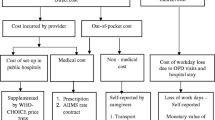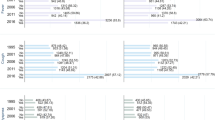Abstract
Objective
To find out health expenditure in public and private sector consultations for common childhood (under 5) morbidities and to compare the clinical practices and the duration of illness for morbidities treated by public and private doctors.
Methods
The present prospective study over 12 months period was undertaken in the field practice area of a urban health centre in rural India. We could interview mothers of 202 enlisted children at monthly interval for one year. At each visits, mothers were asked to recall any morbidity for the child in the past four weeks, date of onset of symptoms and relief, source of treatment and recorded both direct and indirect expenditure. The data was entered and analyzed by using Epi_info 6.04 software package.
Results
Overall, there were 625 episodes of respiratory infection, out of which 377 (60.3%) were treated by private doctors, 158 (25.3%) were treated by government doctors and remaining 90 (14.4%) were treated at home. Significantly more episodes treated in government health facilities i.e., 12 (5.7%) were recommended or done laboratory test where only 13 (2.3%) consultations with private doctors were advised or done laboratory tests (p=0.015). Notably, 145 (25.5%) and 17 (8.1%) episodes treated by private doctors and government doctors respectively received injections (p=0.001). Average total expenditure on treatment of child morbidity was 189 INR (10% of total household income). Families with less monthly income (<1500) had significantly more expenditure (16.1%) on treatment of morbidities than those families who had higher (>1500) monthly income.
Conclusions
About 10% of total household income was spent on the treatment of acute child morbidities. Private providers are preferred for the treatment of acute illnesses where both direct and indirect cost of treatment was high. Household with lower monthly income had to spend more on treatment of their sick children. Hence, while devising PPP and health care financing strategies for urban poor should emphasize to reduce health expenditure.
Similar content being viewed by others
References
Bhatia JC, Cleland J. Health care seeking and expenditure by young Indian mothers in the public and private sectors. Health policy and Planning 2001; 16:55–61.
Srivastava NM, Awasthi S, Agarwal GG. Care-seeking behavior and out-of-pocket expenditure for sick newborns among urban poor in Lucknow, northern India: a prospective follow-up study. BMC Health Services Research [serial online] 2009 [Cited on June 12, 2009]; 9:61. Available from URL: http://www.biomedcentral.com/1472-6963/9/61.
Awasthi S, Pande VK: Family expenditure on sickness episodes of pre-school children in urban slums of Lucknow, North India. Trop Doct 1998, 28:141–146.
Awasthi S, Agarwal S. Determinants of childhood mortality and morbidity in urban slums in India. Indian Pediatrics 2003; 40:1145–1161.
Awasthi S, Pande VK. Family expenditure on sickness episodes of pre-school children in urban slums of Lucknow, North India. J Trop Pediatr 1998; 27: 1–5.
Dongre AR, Deshmukh PR, Garg BS. Awareness and health care seeking for newborn danger signs among mothers in peri urban Wardha. Indian Journal of Pediatrics [Online] April 2009 [Cited on June 17, 2009]; Available from URL: http://www.ncbi.nlm.nih.gov/pubmed/19381514?dopt=Abstract
Dongre AR, Deshmukh PR, Garg BS. Perceptions and health care seeking about newborn danger signs among mothers in rural Wardha. Indian J Pediatr 2008; 75: 325–329.
National Health Policy-2002 [Online]. [Cited on Nov.30. 2009]; Available from URL: http://www.mohfw.nic.in/np2002.htm.
Palmer N. The use of private-sector contracts for primary health care: theory, evidence and lessons for low-income and middle-income countries. Bull World Health Organ. 2000;78:821–829.
Chiranjeevi Gujarat: An innovative partnership with the private sector obstetricians to provide skilled care at birth to the poor in India. [Online]. [Cited on Oct. 11, 2009]; Available from URL: gujhealth.gov.in/Chiranjeevi%20Yojana/…/Chiranjivi_paper_for_ARC_26032008.pdf
Ministry of Health and Family welfare. Government of India. National Urban Health Mission (NUHM) [Online]. [Cited on June 11, 2009]; Available from URL: http://mohfw.nic.in/nrhm.htm.
Gupta I. Inequities in health and health care in India, can the poor hope for a respite. Institute of Economic Growth [Online]. 2003 [Cited on June 12, 2009]; Available from URL: globetrotter.berkeley.edu/macarthur/inequality/papers/GuptaHealth.pdf.
McIntyre D, Thiede M, Dahlgren G, Whitehead M. What are the economic consequences for households of illness and of paying for health care in low and middle income country contexts? Soc Sci Med 2006; 62: 858–865. Epub 2005 Aug 15.
Author information
Authors and Affiliations
Corresponding author
Rights and permissions
About this article
Cite this article
Dongre, A.R., Deshmukh, P.R. & Garg, B.S. Health expenditure and care seeking on acute child morbidities in peri-urban Wardha: A prospective study. Indian J Pediatr 77, 503–507 (2010). https://doi.org/10.1007/s12098-010-0063-8
Received:
Accepted:
Published:
Issue Date:
DOI: https://doi.org/10.1007/s12098-010-0063-8




